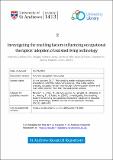Files in this item
Investigating the enabling factors influencing occupational therapists’ adoption of assisted living technology
Item metadata
| dc.contributor.author | McGrath, Colleen | |
| dc.contributor.author | Ellis, Maggie | |
| dc.contributor.author | Harney-Levine, Sarah | |
| dc.contributor.author | Wright, Dave | |
| dc.contributor.author | Williams, Elizabeth A. | |
| dc.contributor.author | Hwang, Faustina | |
| dc.contributor.author | Astell, Arlene | |
| dc.date.accessioned | 2018-09-03T14:30:06Z | |
| dc.date.available | 2018-09-03T14:30:06Z | |
| dc.date.issued | 2017-11-01 | |
| dc.identifier | 250570239 | |
| dc.identifier | 7ea70699-7b1a-4e10-a5b3-e7268d565ef6 | |
| dc.identifier | 85032823886 | |
| dc.identifier | 000414310000005 | |
| dc.identifier.citation | McGrath , C , Ellis , M , Harney-Levine , S , Wright , D , Williams , E A , Hwang , F & Astell , A 2017 , ' Investigating the enabling factors influencing occupational therapists’ adoption of assisted living technology ' , British Journal of Occupational Therapy , vol. 80 , no. 11 , pp. 668-675 . https://doi.org/10.1177/0308022617711669 | en |
| dc.identifier.issn | 0308-0226 | |
| dc.identifier.other | RIS: urn:D0DFD4A83ADA4A85452D141381350D1C | |
| dc.identifier.other | ORCID: /0000-0002-7957-022X/work/37191002 | |
| dc.identifier.uri | https://hdl.handle.net/10023/15947 | |
| dc.description | This research was funded through the Technology Strategy Board. File #TS/10002010/1. | en |
| dc.description.abstract | Introduction: Research into technology adoption has focused on older adults' motivations, with less exploration of the perspective of healthcare providers, including occupational therapists, who are often described as the gatekeepers to assisted living technology. Method: This qualitative study utilized semi-structured interviews and focus groups with 20 occupational therapists in England and Scotland. The goal was to identify those enabling factors necessary for occupational therapists to adopt assisted living technology. Results: Five themes emerged regarding the enablers needed to support the adoption of assisted living technology by occupational therapists, including: (1) a positive client-therapist relationship; (2) affordability; (3) time; (4) increased awareness, education, and training; and (5) usability features of the assisted living technology. Conclusion: With an aging population and the increasing role that technology is playing globally in older adults' lives, it has never been more important for occupational therapists to harness the potential of new, developing, and existing technologies to support people to live and age as well as possible. To accomplish this, however, requires that occupational therapists are equipped with the time, training, and education necessary to offer their clients assisted living technologies that are client-centered, usable, and affordable. | |
| dc.format.extent | 695744 | |
| dc.language.iso | eng | |
| dc.relation.ispartof | British Journal of Occupational Therapy | en |
| dc.subject | Occupational therapists | en |
| dc.subject | Technology adoption | en |
| dc.subject | Assisted living technology | en |
| dc.subject | BF Psychology | en |
| dc.subject | RA0421 Public health. Hygiene. Preventive Medicine | en |
| dc.subject | T Technology (General) | en |
| dc.subject | NDAS | en |
| dc.subject | SDG 3 - Good Health and Well-being | en |
| dc.subject.lcc | BF | en |
| dc.subject.lcc | RA0421 | en |
| dc.subject.lcc | T1 | en |
| dc.title | Investigating the enabling factors influencing occupational therapists’ adoption of assisted living technology | en |
| dc.type | Journal article | en |
| dc.contributor.institution | University of St Andrews. School of Psychology and Neuroscience | en |
| dc.identifier.doi | https://doi.org/10.1177/0308022617711669 | |
| dc.description.status | Peer reviewed | en |
This item appears in the following Collection(s)
Items in the St Andrews Research Repository are protected by copyright, with all rights reserved, unless otherwise indicated.

